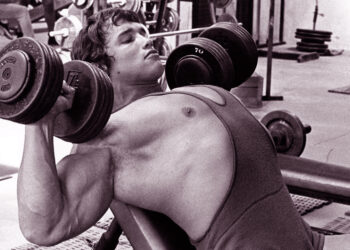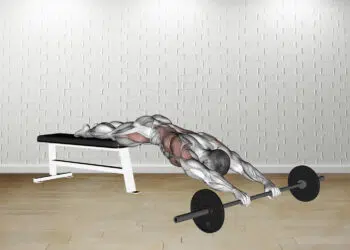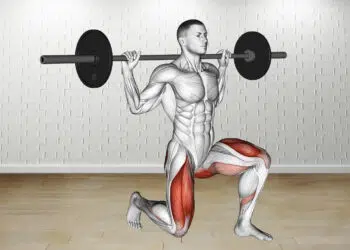The dumbbell sumo squat is a gift from the muscle-building gods for many reasons.
It forces good lifting posture (good lifting habits), builds a stronger core, is easy, convenient, and feels great, helps with flexibility and balance, is versatile, and it’ll build you some wicked legs and glutes so long as you challenge yourself by progressively using more weight and/or doing more reps.
The dumbbell sumo squat is a great alternative to the barbell sumo squat and any squat variation too.
Learn how to get the most from this movement, and we’ve shared some tips, variations, and a plan of action.
Muscles Worked
Because the dumbbell sumo squat is a compound exercise, it works more than one or two muscles. We explained a little about each one below.
Glutes
The glutes or butt and hip muscles are always activated during lower body exercises and activities. But the gluteus maximus, in particular, is what gives the buttocks and hips most of their shape and appearance.
Level Up Your Fitness: Join our 💪 strong community in Fitness Volt Newsletter. Get daily inspiration, expert-backed workouts, nutrition tips, the latest in strength sports, and the support you need to reach your goals. Subscribe for free!
Therefore, we want to really work this muscle to gets those highly sought-after buns of steel.
The function of the gluteus maximus is to extend and externally rotate the thigh.
Quadriceps
Tne quadriceps or quads for short is the large group of muscles that make up most of your upper leg mass. It has four heads; rectus femoris, vastus lateralis, vastus medialis, and vastus intermedialis that help to flex the hips and extend the knees like during squats.
These muscles are also important for posture, walking, and function of the spine and pelvis.
Hamstrings
The hamstring muscles are located opposite the quads on the back of the upper leg. It has three muscles/heads; the semitendinosus, semimembranosus, and biceps femoris.
The hamstrings play an essential role in hip extension, knee flexion, walking, and knee joint stabilization.
If you want to be explosive and athletic then you need strong hamstring muscles.
Calves
The calves are the lower leg muscles consisting of the gastrocnemius and soleus. The gastrocnemius is the larger of the two and what most people think of when it comes to the calf muscles.
It’s the very visible muscle right below the knee that has two heads; medial and lateral and it gives the lower leg a lot of its shape. It joins with the soleus to form the Achilles tendon near the lower portion of the leg.
Then you have the soleus; a large muscle located deep to the gastrocnemius.
The calf muscles plantarflex (point the toes down) the foot and ankle. They are also important for posture, and athletic movements. Although they do have an uneven ratio of fast and slow-twitch fibers.
The gastrocnemius is composed of mostly fast-twitch fibers that make it better suited for quick and explosive movements. The soleus contains more slow-twitch fibers and is, therefore, better suited for endurance-type activities.
Core
The core group of muscles includes the abdominals, obliques, deep core muscles, and even the spinal erectors. These muscles contribute to trunk movement and spine stability.
Squats are a very effective exercise for building a strong and muscular core.
Adductor Magnus
The adductor magnus is a powerful thigh adductor muscle which means it plays an essential role when the thighs are brought from a wide position to close together.
It also helps with lateral and medial rotation of the leg and can extend the hip joint.
Level Up Your Fitness: Join our 💪 strong community in Fitness Volt Newsletter. Get daily inspiration, expert-backed workouts, nutrition tips, the latest in strength sports, and the support you need to reach your goals. Subscribe for free!
How To Do The Dumbbell Sumo Squat
- Grab your dumbbell and grip it either with one hand in front of the other or hold the top part of the dumbbell.
- Move your feet out into a wider stance and position your feet slightly outward.
- Keep your back straight, core tight, and hinge forward at the hips about 30 degrees.
- Squat down until your upper legs are about parallel or to your preferred depth and then drive through your midfoot and heels into a standing position.
Here’s a video example…
Dumbbell sumo squat tips
- Do a proper warm-up before performing progressively heavier sets of this exercise.
- You may need to start off by using only your bodyweight as not everyone will need to use additional resistance.
- Use two weights to increase the difficulty of the exercise.
- Maintaining proper lifting posture is essential to safety and maximizing performance. Keep the weights close to your center of gravity.
- Avoid allowing your knees to travel too far forward over your feet as this can cause knee discomfort.
- Find a stance that’s most comfortable for you.
4 Variations/Alternatives
There’s nothing wrong with dumbbell sumo squat. In fact, we highly recommend it as an effective lower body exercise. But using variations and alternatives keeps things interesting, plus it may be better for some people, and it may allow you to use weight that you otherwise couldn’t.
Barbell sumo squat
You could, of course, still do the barbell variation. Although, we’d be dishonest if we said that everyone who does the dumbbell variation would be interested in using a barbell.
But it would allow more weight to be used and therefore possibly have a better effect on increasing strength.
It’s just an option though.
Also consider the sumo deadlift that can really really help you to take your strength development to the next level.
Goblet squat
The goblet squat is a similar exercise to the dumbbell sumo squat, however, the weight is held at chest level. This may actually cause the quads to work a little harder too due to having a more upright posture.
And that brings us to one of the biggest benefits of using this exercise; it really forces thoracic extension which can have a positive impact on overall lifting posture.
Goblet Squat Exercise Guide – Benefits, How-To, and Variations
Dumbbell squat
There’s also the basic dumbbell squat that may use a narrow stance and a more natural, upright stance as the dumbbells are held on by your sides rather than in front. It may actually be the better choice if using heavy weights.
Kettlebell swing
The kettlebell swing is one of the greatest exercises for developing strength, explosiveness, and power. It’s a superior posterior chain movement and although it’s not the dumbbell sumo squat just using a kettlebell instead, it does involve a similar starting position.
Plus, you could also use a kettlebell for the sumo squat so we might as well get more benefits from it.
How To Incorporate The Dumbbell Sumo Squat Into Your Training Routine
Whether you do the dumbbell sumo squat as a standalone exercise on leg day (only it shouldn’t be the only exercise you ever do), or in combination with other exercises, you’ll benefit from it.
Many don’t have much equipment to train with and the beauty of this exercise is you can use any weight to do it, not just a dumbbell. Short on time? it’s great for that. Want to add more intensity to your workouts, do a superset where you perform an exercise and move right into the dumbbell sumo squat.
The possibilities are endless, really.
Try these at-home leg workouts for a stronger lower body.
But if you are someone who does heavy compound movements, it’s wise to do those first when you have the most strength. Although, how you incorporate any exercise really depends on your goals.
Sets/reps
We recommend doing at least 2-4 sets of this exercise and varying your reps. For example, if you wanted to get stronger in this exercise, a rep range of 5-7 reps is ideal. For muscle growth, use a more moderate rep range of 8-15 and to build muscular endurance, aim for 20-30 reps.
This isn’t set in stone and any rep range can be beneficial for any goal. But sticking to a set rep range may be best for reaching a specific goal faster.
Wrapping Up
The dumbbell sumo squat is a fantastic exercise that anyone can effectively use to improve their lower body development and other aspects of fitness. And no, it’s not just for endurance athletes and cardio classes either; use enough weight and training methods, and the toughest of em will find it to be very challenging.
Related: The 13 Best Methods For Increasing Training Intensity
Interested in measuring your progress? Check out our strength standards for Goblet Squat, Deadlift, Hip Extension, and more.








